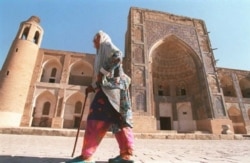Nisa sits at the foot of a range of reddish-yellow hills, laid out to take advantage of the almost constant breezes that blow through the ravines in those hills and cools the ancient city while the areas around it bake in the heat.
For travelers some 1,500 to 2,000 years ago -- when Nisa was at its zenith -- the city must have looked like paradise after a journey through deserts where summer temperatures climb to well over 50 degrees Celsius.
Today, only the lower walls and bases of the columns remain in Nisa, about 15 kilometers from Turkmenistan's capital, Ashgabat.
A City At A Crossroads
"It's a historical and archeological site of great significance," Francis Childe, the section chief for Asia and the Pacific in the World Heritage Center at UNESCO in Paris, tells RFE/RL. "The Parthian Empire was one of the most powerful and influential civilizations of the ancient world, and Nisa itself dates from the third millennium B.C. right through into the current era, around the third century A.D. It was a rival of Rome. [Parthia was] one of the great civilizations of Central Asia, combining influences not only passing from east and west but also from north and south."
Not surprisingly, the architecture of Nisa includes local influences, as well as traces of Roman and Bactrian architecture. The area's hot, dry climate helped keep the site remarkably well preserved, something Childe said makes it an ideal place to be added to the World Heritage List.
"The integrity and the authenticity of the property itself, the surrounding landscape, its conservation, and several other factors mean that this is really an outstanding site, not just of Central Asia but in terms of world heritage itself," he says.
Soviet scholars conducted some archeological work at Nisa after World War II. But serious excavation of Nisa only started again during the 1990s, when a team from the Italy's University of Turin arrived.
UNESCO's recognition of Nisa may also help reduce the problem of theft from the site. As happened at the Great Wall of China, many nearby residents in the Nisa area have found a ready source of building materials by simply taking stones from Nisa's ruins.
Childe says the inclusion of Nisa on the list also brings tangible benefits that can help preserve the site.
"There is a World Heritage Fund and [for] sites that are on the list, government authorities can apply for help in terms of its conservation, [they] can apply for establishing or improving management structure, training for the national staff that are looking after it," Childe says. "Sometimes we arrange for regional and even international training as well, so there is an ongoing maintenance...in terms of our interrelation with the national authorities and with the experts who are involved. And that's actually a very important part of the function that we here at the World Heritage Center play."
Restoring A Nearly Lost Heritage
Childe added that the preservation of ancient cities such as Nisa helps give back to the peoples of Central Asia a past they nearly lost when the region was part of the Soviet Union.
"For the ex-Soviet republics, this whole question of their cultural identity and their cultural heritage is a really important one," he says. "In many ways, they were cut off from their past in Soviet times. Now we find, in fact, cities that existed in the ex-Soviet republics -- including Turkmenistan, Kyrgyzstan, Kazakhstan -- some of them many thousands of years old, attesting to very high levels of civilization. So in a way, the rediscovery of these sites has also to do with the rediscovery of their own past and of their own history and with a new sense of pride in who they were as well as what they are today."
This pride is evident from the Turkmen state television report about the inclusion of Nisa on the World Heritage List.
"This is already the third ancient city in Turkmenistan to be put on the list," Turkmen television reported recently. "In 1999, another historical site in Turkmenistan was included on the UNESCO list of World Heritage Sites, ancient Merv, where the famous mausoleum of Sultan Sanjar is located. In 2005, UNESCO's World Heritage Committee decided to add to the list Kunyaurgench, the largest archeological park in northern Turkmenistan, on the left bank of the Amu-Darya [River]. It is a broad zone with many ruins and monuments bordering on the contemporary city of Kunyaurgench."
Childe said there are already close to 1,000 cultural-heritage sites in Central Asia, and added that more are sure to be added to the list in coming years.
(Guvanch Geraev of RFE/RL's Turkmen Service contributed to this report.)
| FURTHER READING | |
|
Rethinking The Silk Road
An important aspect of all Silk Road nations is that their specific identities can be explained by what he calls "crossroadness." more
|
Preserving The Jewels Of The Silk Road
Merv, a city believed to be the world's most populous in the mid-12th century, is safe. So, too, is the architecture of Bukhara and Samarkand. But many ancient cities aren't so lucky. more
|
In Tune With Central Asia
CENTRAL EUROPE MEETS CENTRAL ASIA: A Prague-based festival featuring nearly 100 films about music from around the world placed a spotlight on the musical culture of Central Asia -- still one of the world's best-kept secrets. Films gave a glimpse into the lives of musicians in Kyrgyzstan and Uzbekistan and Radio Free Europe/Radio Liberty was on hand for a live musical performance.






















